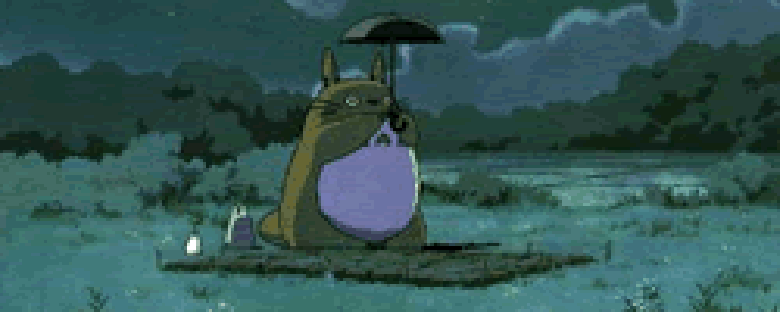Reviews
Tonari no Totoro
Hayao Miyazaki
Japan, 1988
Credits
Review by Rumsey Taylor
Posted on 11 July 2004
Source Fox VHS
The opening scene in Hayao Miyazaki’s My Neighbor Totoro is panicked with excitement, and it is about, simply, moving into a new house. Seeing how the experience results in such emotion in its two main characters (both girls, both very young) is a distinguishing mark in both the film and the director’s oeuvre.
Watching Totoro one is reminded how in American animated films the conflict involves a great fantasy, and is often diluted with several musical numbers. Its opening and closing credits excepted (which amount to musical “menus”), My Neighbor Totoro contains no songs, and begins, in contrast and reiteration, with the excitement derived in moving into a new house.
Satsuki, her younger sister Mei, and their father Tatsuo have moved to a more rural location, nearer to the hospital that nurses their ailing mother. The mother’s sickness is an unexpected drama that elicits the family’s sorrow and concern. There is a later scene in which Satsuki receives an emergency telegram that suggests a sudden change in her mother’s health, and she panics. Mei hears of the news, and leaves, on foot, to reach her mother’s side. The hospital is miles away. Mei is considered lost, and her absence leads to an especially harrowing scene in which several neighbors scour a pond for her little body.
I stress this drama, because it is an element that achieves real depth. My Neighbor Totoro has a realistic (notice how Mei emulates her older sister) and dramatic maturity and an ingenuous sensibility (as with its opening, many scenes inherit a child’s curious wonder). In contrast, there is fantasy, one, armed with Miyazaki’s strength as its author, imaginative and totally original.
Mei finds, one day around her house, a trail of acorns, which leads to a Totoro. It is a silent furry creature best described as a plump, rounded rabbit. She chases it into nearby woods, falls through a wooded chasm onto the belly of a much larger one. A much, much larger one. Eventually, Satsuki meets the company of the giant Totoro, and the sisters exclaim their meeting to their father:
Satsuki: “It was scary!!”
Mei: “And I was scared!!”
Satsuki: “We saw TOTORO!!”
Mei: “We saw TOTORO!!”
Satsuki: “We saw TOTORO!!”
Mei: “We saw TOTORO!!”
Their unstifled enthusiasm may be childish, though the children’s great potential for wonder is preyed upon (forgivably, it is also contagious). The visionary scenes with Totoro confirm that the film’s prior exposition is dubiously simplistic.
The Totoro is a benevolent and mysterious beast. He may be the King of the Forest, and he may be imagined. Only Satsuki and Mei locate him, and each meeting is an opportunity for adventure. The sisters find him on their lawn late in the night. He spins a large top at his feet, they hug his belly, and the group (including the smaller Totoros) fly through the night. It is a wildly imaginative scene.
My Neighbor Totoro reminds that film can be a creation, a work with little exterior influence. Watching the film with little prior familiarity, I found it austere for its originality, and I laud it for precisely the same reason.
We don’t do comments anymore, but you may contact us here or find us on Twitter or Facebook.



